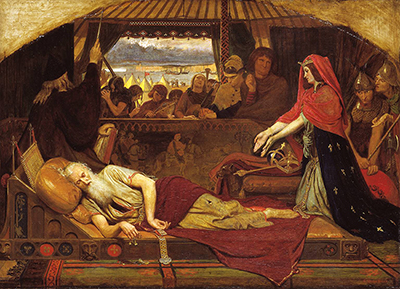Lear and Cordelia is one of three paintings by Ford Madox Brown depicting events in Shakespeare's King Lear, all of them based on pen and ink drawings produced when the artist was in Paris in 1843-4.
Brown attended a performance of the play in London in May 1848, and started work on this, the first of the three paintings, in November of the same year. The picture shows Act IV Scene vii, the French camp, in Cordelia's tent at Dover. The King is sleeping as he holds some keys, with a weary pose and thin white hair that suggest old age, while musicians play outside. The physician to the left exhorts them to increase their volume, but Cordelia wants her father to sleep. She kneels with outstretched arms in a caring gesture, and starts a lament, reproduced in the spandrels here.
The melancholy foreground figures contrast with the throng seen through the window, and especially with the bright and cheerful background beyond. Most of the cast were models, with Dante Gabriel Rossetti playing the Fool who scowls at Lear. The sixth-century costumes allowed Brown to portray a time when he considered dark deeds were more prevalent, while a scene from the Bayeaux Tapestry is shown behind the sleeping man.
Lear and Cordelia was first displayed at the Free Exhibition of 1849. Despite its popularity, it remained unsold until 1854, allowing the artist to continue to work on it. Today, it is part of the Tate Gallery's collection in London. Although Ford Madox Brown is associated with the Pre-Raphaelite Brotherhood, he preceded them by a few years, and was never actually a member. His graphic style is more reminiscent of Hogarth or Holbein than of the airy subjects chosen by his associates. Brown was also a talented designer and draughtsman, having studied drawing in Paris, and became a founder member of William Morris's company. He sometimes painted outside.
Unlike those of his companions, Ford Madox Brown's figures are less than perfect, and chaotic groups clash with bright colours, reminiscent of real street scenes. While the others were products of the Royal Academy schools, Brown had been born in Calais, passing through Belgian academies, and was influenced by the details in Dutch and Flemish paintings. A trip to Italy, and exposure to work by Fra Angelico and Giotto, reinforced this interest in early paintings.
Brown spent several years in Manchester, where he was commissioned to complete twelve murals for its magnificent Town Hall, and the city's no-nonsense attitudes suited his philosophy. The Pre-Raphaelites continue to be relevant today, having broken new ground with their ideas on painting and subject matter. Some consider them to be the first modern painters, and it could be argued that Ford Madox Brown's slightly different take on the genre makes him the most modern of all, with Lear and Cordelia being a good example of his style.




